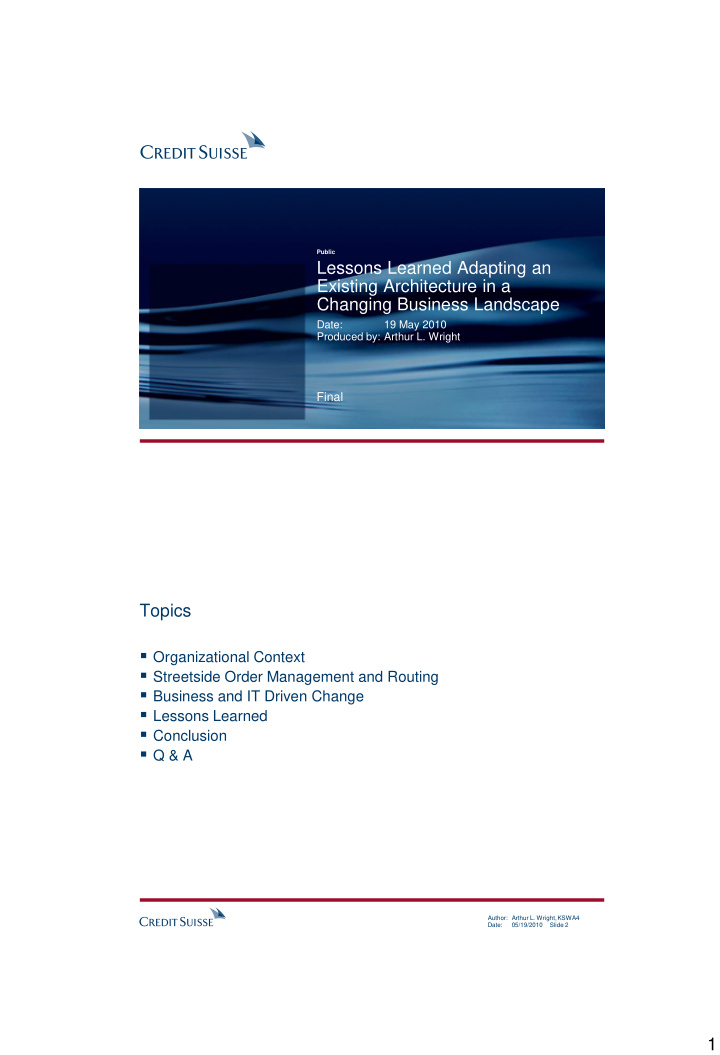



Public Lessons Learned Adapting an Existing Architecture in a Changing Business Landscape Date: 19 May 2010 Produced by: Arthur L. Wright Final Topics Organizational Context Streetside Order Management and Routing Business and IT Driven Change Lessons Learned Conclusion Q & A Author: Arthur L. Wright, KSWA4 Date: 05/19/2010 Slide 2 1
Credit Suisse Credit Suisse locations Regional headquarters Centers of Excellence Author: Arthur L. Wright, KSWA4 Date: 05/19/2010 Slide 3 The Program Streetside Program Broker & Client Streetside Compliance & Product Connectivity International Maintenance Enhancements • European Operating • Inbound Financial • Maintenance • eTicket Institutions Model (EUROM) Releases • Advanced Execution • Split Production • Inbound Corporate & • Securities Journal Services (AES) • Full Singapore • Order Book • Business Continuity Institutional Clients • Outbound Brokers Functionality Reconciliation Planning (BCP) • Markets in Financial • COTS Upgrades • Adaptive Instruments Directive (MiFID) Maintenance • Optimized Financial Instruments Processing (OFIP) Author: Arthur L. Wright, KSWA4 Date: 05/19/2010 Slide 4 2
Functional Context Streetside Process Send Street Client Ticket Client Market Data Provider Order Trade with Execute Prop Desk Order Exchange Advisory Manually Import Settle Trade Reference Broker Data Order Fulfillment Archive Maintain Business Products Transactions Internal Market Post Trade UML 2.1 Settlement Agent Product Provider Archive Reference Provider Quote Provider Author: Arthur L. Wright, KSWA4 Date: 05/19/2010 Slide 5 Communication Product Client Trader Broker Provider Streetside FIX Monitor FIX RAVE RAVE DMS RAVE Engine Client Engine Monitor RAVE RAVE Publisher Server Order RAVE MORTR Pooler Hub Database MORTR – Mid Office Router RAVE – Rules and Validation Engine DMS – Data Management Server (RAVE) UML 2.1 All components access database, except FIX Engine and Monitor Client Author: Arthur L. Wright, KSWA4 Date: 05/19/2010 Slide 6 3
Starting Point Legacy Replacement Leveraged existing CS application, AGORA – Disaster Recovery (-) – Compliance Checking (-) – Intraday Reporting (-) The original team decided to replace AGORA – In memory database with a relational database – New software component, the OrderHub. High personnel turnover – Collaboration, people and technical challenges Architectural Changes – Missed or partially implemented requirements e.g. throughput, service times, and availability – New, changed interfaces in support of pressing functional requirements Investment between USD 10-15 M a year Author: Arthur L. Wright, KSWA4 Date: 05/19/2010 Slide 7 Business and IT Driven Change Past Upcoming Fixed income E-Ticket – Better support for telephone Derivatives based trading activities. New brokers and clients. International location rollouts. Business Disaster Recovery (DR/BCP) Integration with Advanced Execution Services (AES) Legacy dependencies Securities Journal + Reporting Rewritten Pooler Reconciliation Decommissioned JCopy, TNS Reduction of comm. protocols Product Line Architecture Virtualization Database & Hardware migration IT Benchmarking + COTS Logging Source Configuration Management Improved Scalability (SCM) system migration COTS Persistence layer Integration: next generation client trading Continuous Integration system and settlement system CMMI (Level 2 and 3) Author: Arthur L. Wright, KSWA4 Date: 05/19/2010 Slide 8 4
People build systems Interpersonal relations + Organizational relations Affect Architecture Author: Arthur L. Wright, KSWA4 Date: 05/19/2010 Slide 9 Time spent evaluating options … …is time well spent COTS Eval. Methods ADD™ ATAM™ Tools for – Analysis – Decision Making PLanguage Author: Arthur L. Wright, KSWA4 Date: 05/19/2010 Slide 10 5
When producing design documentation … …focus on important stakeholders. Template Documents Stakeholder oriented Views UML Template Model CMMI Author: Arthur L. Wright, KSWA4 Date: 05/19/2010 Slide 11 Have an architectural road map Vision Align tactics and strategy Reverse failure Accommodate change Author: Arthur L. Wright, KSWA4 Date: 05/19/2010 Slide 12 6
What’s in my roadmap? Considers stakeholder priorities e.g.: Example: Time to market on new features. I. Single protocol for asynchronous, Stability and throughput, then synchronous communication - for performance. maintainability. Expect maintainability always II. Multi instance capable/clusterable components – failover and throughput Commercial rule engine – Each step consists of: III. Components and connectors view maintainability, flexibility Component responsibilities/partitioning IV. Enterprise service bus for features like Important quality attributes - stakeholders. adaptors, routing – maintainability, Estimates scalability. Technical dependencies Data access layer – performance V. through caching, scalability, maintainability. VI. Domain oriented components – maintainability, performance Author: Arthur L. Wright, KSWA4 Date: 05/19/2010 Slide 13 Conclusion Thank you. Organizers Audience Author: Arthur L. Wright, KSWA4 Date: 05/19/2010 Slide 14 7
Q & A Author: Arthur L. Wright, KSWA4 Date: 05/19/2010 Slide 15 References [FIX] FIX Protocol Technical Specifications, http://www.fixprotocol.org/specifications/ [EIP] Enterprise Integration Patterns: Designing Building and Deploying Messaging Solutions, 2003, Hohpe and Woolf [COTS] A Process for COTS Software Product Evaluation, Cornelia-Dorda et al., CMU/SEI-2003-TR-017 [DATM] Data Model as an Architectural View, Merson, CMU/SEI-2009-TN-024 [SAPP] Software Architecture Principles in Practice, 2 nd Ed., Bass et al. [DSA] Documenting Software Architecture: Views and Beyond, 2 nd Ed., Clements et al. [PLANG] Rich Requirement Specs: The use of Planguage to clarify requirements, May 2006,Tom Gilb [CSBR] Business Review 2009, https://www.credit- suisse.com/investors/en/reports/annual_reporting.jsp Author: Arthur L. Wright, KSWA4 Date: 05/19/2010 Slide 16 8
Recommend
More recommend